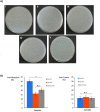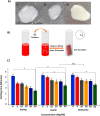Morphological, cytotoxicity, and coagulation assessments of perlite as a new hemostatic biomaterial
- PMID: 36825295
- PMCID: PMC9941756
- DOI: 10.1039/d2ra07795g
Morphological, cytotoxicity, and coagulation assessments of perlite as a new hemostatic biomaterial
Abstract
Hemorrhage control is vital for clinical outcomes after surgical treatment and pre-hospital trauma injuries. Numerous biomaterials have been investigated to control surgical and traumatic bleeding. In this study, for the first time, perlite was introduced as an aluminosilicate biomaterial and compared with other ceramics such as kaolin and bentonite in terms of morphology, cytotoxicity, mutagenicity, and hemostatic evaluations. Cellular studies showed that perlite has excellent viability, good cell adhesion, and high anti-mutagenicity. Coagulation results demonstrated that the shortest clotting time (140 seconds with a concentration of 50 mg mL-1) was obtained for perlite samples compared to other samples. Therefore, perlite seems most efficient as a biocompatible ceramic for hemorrhage control and other biomaterial designs.
This journal is © The Royal Society of Chemistry.
Conflict of interest statement
The authors declare that they have no known competing financial interests or personal relationships that could have appeared to influence the work reported in this paper.
Figures






Similar articles
-
Fabrication of thrombin loaded TEMPO-oxidized cellulose nanofiber-gelatin sponges and their hemostatic behavior in rat liver hemorrhage model.J Biomater Sci Polym Ed. 2022 Mar;33(4):499-516. doi: 10.1080/09205063.2021.1992877. Epub 2021 Oct 20. J Biomater Sci Polym Ed. 2022. PMID: 34644247
-
Assessing Coagulation by Rotational Thromboelastometry (ROTEM) in Rivaroxaban-Anticoagulated Blood Using Hemostatic Agents.Prehosp Disaster Med. 2017 Oct;32(5):580-587. doi: 10.1017/S1049023X17006641. Epub 2017 Jun 19. Prehosp Disaster Med. 2017. PMID: 28625215
-
A comparative study of the removal of trivalent chromium from aqueous solutions by bentonite and expanded perlite.J Hazard Mater. 2002 Nov 11;95(1-2):29-46. doi: 10.1016/s0304-3894(01)00382-x. J Hazard Mater. 2002. PMID: 12409237
-
[Hemoglobin-oriented and coagulation factor-based algorithm : Effect on transfusion needs and standardized mortality rate in massively transfused trauma patients].Anaesthesist. 2015 Nov;64(11):828-38. doi: 10.1007/s00101-015-0093-8. Epub 2015 Oct 9. Anaesthesist. 2015. PMID: 26453580 Review. German.
-
Engineered Hemostatic Biomaterials for Sealing Wounds.Chem Rev. 2022 Aug 10;122(15):12864-12903. doi: 10.1021/acs.chemrev.1c01015. Epub 2022 Jun 22. Chem Rev. 2022. PMID: 35731958 Review.
References
-
- Robinson K. Controlling Bleeding in the Field: Hemostatic Powders and Dressings Debut in the Prehospital Setting. J. Emerg. Nurs. 2004;30:160–161. - PubMed
-
- Neuffer M. C. McDivitt J. Rose D. King K. Cloonan C. C. Vayer J. S. Hemostatic Dressings for the First Responder: A Review. Mil. Med. 2004;169:716–720. - PubMed
-
- Vestergaard Rikke F. Nielsen Per H. Terp Kim A. Søballe K. Andersen G. Hasenkam John M. Effect of Hemostatic Material on Sternal Healing After Cardiac Surgery. Ann. Thorac. Surg. 2014;97(1):153–160. - PubMed
-
- Seyednejad H. Imani M. Jamieson T. Seifalian A. M. Topical Haemostatic Agents. Br. J. Surg. 2008;95:1197–1225. - PubMed
-
- Stewart R. Myers J. Dent D. Ermis P. Gray G. A. Villarreal R. et al ., Seven Hundred Fifty-Three Consecutive Deaths in a Level I Trauma Center: The Argument for Injury Prevention. J. Trauma. 2003;54:66–71. - PubMed
LinkOut - more resources
Full Text Sources

